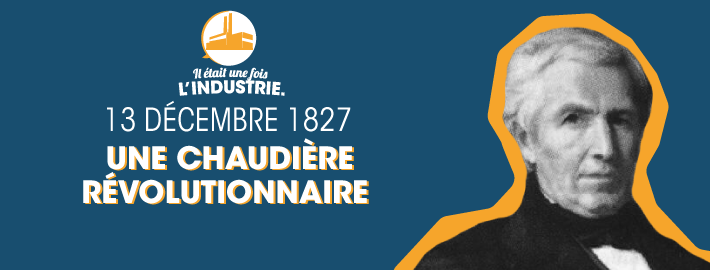GLOBAL
INDUSTRIE
News
Share on

13 December 1827: a revolutionary boiler
This week it’s full steam ahead with the story of a boiler for which the patent was filed on the 13th of December 1827 by Marc Seguin: a symbol of the industrial revolution which was to sweep away the century. Let’s raise the curtain on a particularly heated episode in history.
A FAMILY AIR
From the day he was born into a family of drapers in Annonay on the 20th of April 1786, Marc-François Seguin’s destiny seemed to lie in the air. His mother was one of the Montgolfier family, making him the grand-nephew of Joseph and Étienne, the famous inventors of hot air balloons. It was moreover under the influence of the former, who was also a demonstrator at the Conservatory of Arts and Crafts, that he developed a marked taste for science during a stay in Paris.
Thus, although he started work in his father’s shop in 1805, he quickly made a name for himself as an engineer, scientist and inventor. Curious by nature, he made several trips to England and Switzerland, kept himself up to date with the latest discoveries and took a particular interest in the strength of materials. Dreaming of doing away with the ferries which were still used to cross the vast majority of waterways, he thus built the first iron cable bridge over the Cance, the river running through his home town of Annonay, in 1823, and quickly distinguished himself in the construction of suspension bridges.
BOILERS, BOATS AND STEAM ENGINES
It was in the following year however, in 1824, that he developed an invention which was to earn him a place in history and for which he filed a patent on the 12th of December 1827. In reality, this was more an improvement than a creation. The tubular boiler had in fact been invented more than forty years earlier by another Frenchman, Charles Dallery. Originally, the water circulated in it inside tubes – hence the name – heated externally by gases. Marc Seguin developed a reverse system: it was the inside of the fifty or so small-diameter fire tubes which was heated by combustion gases and which raised the water, now flowing around them, to boiling point. This considerably increased the heat exchange surface and consequently the boiler’s efficiency.
He was quick to test his invention on boats which sailed on the Rhône and on the steam locomotive he used on the railway between Saint-Etienne and Lyon, around a dozen copies of which were subsequently built. The results were striking: his boiler produced 1,200 kilograms of steam per hour instead of 300, which raised the average speed of the machine to 30 kilometers per hour instead of 16.
A MAN OF BOUNDLESS ENERGY
Marc Seguin’s talents were thus not limited to a single field. A designer of steam boats, the creator of a steam haulage company on the Rhone and a builder of revolutionary suspension bridges which were simultaneously very strong and affordable, he also distinguished himself in the construction of locomotives and was the originator of the railway company linking Saint-Etienne to Lyon. He is also considered to have been a pioneer of aviation: in 1846, after observing the poultry in his farmyard, he developed an ancestor of the airplane which he managed to get to fly 15 to 20 centimeters above the ground, and in 1866 he published a "Dissertation on Aviation or Aerial Navigation".
OTHER EVENTS WHICH HAPPENED THIS WEEK:
- 14 December (1900): Max Planck presents his quantum theory in Berlin
- 14 December (1940): Plutonium is isolated for the first time at the University of Berkeley
- 14 December (1972): the American Eugene Cernan is the last man to walk on the Moon
- 15 December (1965): first successful space rendezvous in history between the manned capsules Gemini VI and Gemini VII
- 15 December (1996): the American companies Boeing and McDonnell Douglas announce their merger, thus creating the biggest aerospace company in the world
- 15 December (2000): permanent closure of the Chernobyl nuclear power plant
- 15 December (2016): the European Union’s satellite positioning system Galileo becomes operational
- 16 December (2004): the Voyager 1 probe leaves the heliosphere, thus becoming the first human creation to navigate beyond the solar system
- 17 December (1903): the Wright Brothers fly a plane built by them, the Flyer, on Kitty Hawk Beach in North Carolina
- 17 December (1938): the phenomenon of nuclear fission is discovered by the German chemist Otto Hahn, marking the birth of this new energy
- 18 December (1958): launch of SCORE, the world’s first telecommunications satellite, by the United States
- 18 December (1970): Aerospatiale and Deutsche Airbus officially form Airbus
- 18 December (2013): first implant of a “total” artificial heart at the Georges Pompidou European Hospital in Paris
- 18 December (2015): closure of Kellingley colliery, the last deep coal mine in Britain
- 19 December (1877): Thomas Edison patents the phonograph
2021.12.13